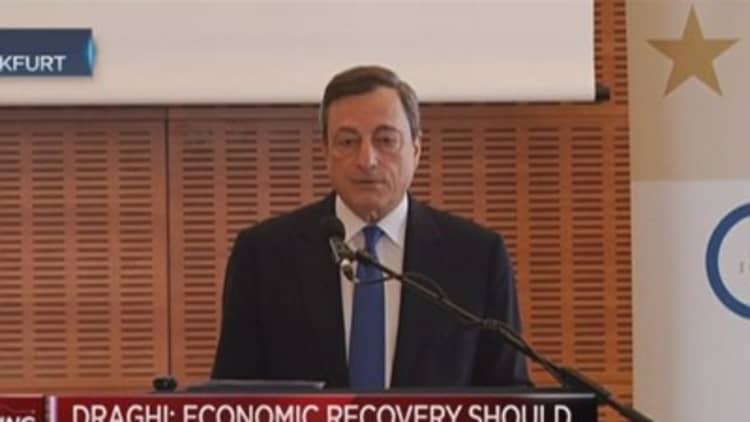
German 10-year government bonds yields hit a new record low Wednesday, as a backdrop of monetary stimulus ratchets up the divergence between bond markets in the U.S. and Europe.
The yield on the 10-year German Bund, the benchmark for borrowing costs in the euro zone, fell to a low of 0.1980 percent Wednesday before ticking slightly higher.
Read MorePrepare for euro-dollar parity—and fast
It has shed about 32 basis points so far this year and about 18 basis points this week alone, as the European Central Bank kicked off a 1 trillion euro ($1.06 trillion) asset-purchase program to boost growth in the 19-member euro zone.
"We are at record lows on Bund yields but this is consistent with a backdrop of exceptionally loose monetary policy, which will remain in place for some time," John Higgins, chief market economist at Capital Economics in London, told CNBC.
And as quantitative easing in the euro zone drives yields lower, it has triggered a rare divergence in global bond markets with the fall in Bund yields contrasting with a rise in U.S. Treasury yields.
The 10-year U.S. Treasury yield was trading around 2.14 percent Wednesday and is seen moving higher, as expectations for a U.S. interest rate rise this year grow following strong economic data releases.
The spread between U.S. Treasury yields at Bunds is at its widest in almost three decades and the differing paths for U.S. and euro zone monetary policy helped send the euro to a fresh 12-year low against the dollar Wednesday.
"One of the main messages we've been telling clients is that there would be a divergence in U.S. and European bond markets, and that has happened and will persist because of the divergence in monetary policy," Higgins said.
He expected Bund yields to end the year at about 0.5 percent and forecast U.S. 10-year Treasury yields at 2.5 percent.
Analysts said it was hard to say how long yields in the euro zone would remain low following recent sharp falls which have sent some short-dated yields into negative territory.
"As the Sovereign Bank of Europe's QE (quantitative easing) buying spree dominates markets, the numbers underlying the great European bond convolution are causing mounting concern," said Bill Blain, a strategist at Mint Partners, in a note.
"The average yield on investment-grade euro corporate bonds is now an utterly meaningless 0.88 percent compared to 3.11 percent in dollars (according to Bloomberg). Where would euro bonds yield without QE?"
At a conference in Frankfurt, ECB chief Mario Draghi said the central bank's bond-buying program may be protecting euro zone states from contagion from Greece's fiscal woes.
"Would you weigh the risk of Portugal (for instance) at the current 1.70 percent 10-year yield, or would 4.5 percent be a fairer risk/return?," said Mint Partners' Blain. "Well, that depends on the circumstances and the circumstances are that someone in a Frankfurt office is prepared to buy Portugal at that yield so that is the yield."
Follow us on Twitter: @CNBCWorld


